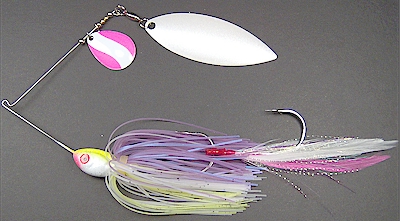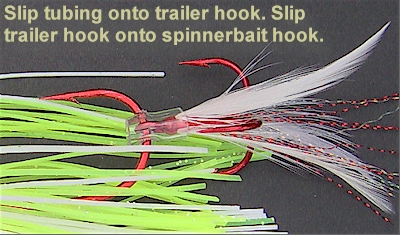Adding Feather Treble Trailers to Spinnerbaits & Buzzbaits
Bassdozer's Best Bass Fishing Tip Ever!
Something I do often with a spinnerbait or buzzbait is to slip a feather treble trailer onto the shank of the bait's primary single hook.
Now I'm not saying no one else has ever done this - but I've never heard of anyone else using a feather treble trailer on a spinnerbait or buzzbait unless I showed them first. Anyone who's ever been taught this trick by me has used it themselves from that day onward. I've also published this little trick here and there on the web for about the past ten years, but it still it is not common knowledge or in widespread usage yet.
I came up with this original idea one day when I was testing many different models of crankbaits, jerkbaits and topwater hard baits to see which models would work better with a feather treble tail hook. Some hard baits do work better, some do not, and there's no way to know unless you try them. In the middle of all this, it just dawned on me to also test a spinnerbait or buzzbait with a feather treble trailer hook - and the results proved to be absolutely astounding in terms of so many more fish hooked and landed on the feather treble trailer.
It's super simple, anyone can rig one, and of all the bass fishing tips you may ever come across in magazines, articles, TV or on the water, this is one tip that can really pay off big for you!
It will greatly increase the number of fish you hook and land on spinnerbaits and buzzbaits. It is particularly deadly for smallmouth and spotted bass that slash at spinnerbaits and tend to run smaller, therefore have smaller mouths than their largemouth cousins. It is also essential equipment for all small to mid-size largemouth that often just nip at instead of completely engulf a spinerbait like bigger bucketmouth.
You will amaze yourself at how many bass (most of them) come in only pinned on the feather treble. And while some fishing spots are too snaggy or weedy for a treble trailer, those spots are in the minority. There are far more places you can sling a feather treble than you can't. Even with a feather treble trailer, that big vee-shaped wire arm spread far apart in front of the spinnerbait makes it one of the most snagless lures you can throw. The wire arm functions exactly like the fiber weedguard on a flipping jig. The feather treble trailer the way I show you how to rig it, it isn't free-swinging. It pretty much always stays in place directly in-line behind the rest of the spinnerbait. So the feather treble always stays well-protected from snags by the wire arm and spinnerbait body.
The treble I add to spinnerbaits and buzzbaits is a feather teaser sweetened with feathers and reflective mylar flash tied on it to stimulate more strikes.
You are not only adding a trailer hook but also adding a trailer bait with a feather treble:
- Trailer Hook: The treble provides you with three additional hooks, each 120 degrees apart in a full circle to nab fish striking from any angle, in addition to the fourth upright single hook molded into the bait itself.
- Trailer Bait: The feathers and mylar flash provide you the benefits of adding a second "trailer" bait to the primary lure. Adding the feathers is just like adding a trailer bait to a flipping jig.
Our flyfishing brethren have always known the powerful attraction that feathers and mylar material holds over trout. Ditto for bass. By using a feather treble as a trailer you are adding a second completely separate lure to a spinnerbait. Definitely treat and fish the feather treble as if it is a separate second lure, and sometimes you may get the notion that all a bass wants is the feather add-on, not the spinnerbait itself.
There are times the fish become more interested in selectively striking the feather trailer as an independent bait. That is, fish will move their strike point to hit the feather trailer only, to pluck that out of the bait ball, without wanting to hit the skirt at all. When that's the case, I may trim the spinnerbait or buzzbait's silicone skirt shorter in order to separate the feather treble and make it even more independent from the skirt.
A spinnerbait with a feather trailer creates a "bait ball" and by that, I mean you may have two blades (often different hues); third, the painted head; fourth, the multi-strand skirt; and finally, the feathered trailer hook failing to keep up with the others in the bait ball which signals it is easy pickings to bass.
All of these discrete components move in unison since they are all connected - the blades, the painted head, the skirt strands, the feather trailer. They swim synchronously in the instinctively recognized, often unbreakable defense motion of a prey school, which is to move in perfect unison. Yet the feather trailer is last in line - and most vulnerable. It is not uncommon to see an actual baitfish or two swimming along very close behind a spinnerbait, and that's what the feather treble adds behind the bait ball - a laggard that becomes the target for a strike.
So when your strike ratio (plus hook-up and landing ratio) goes up by adding a feather trailer to a spinnerbait, the bass are not always trying to strike the spinnerbait itself any more. They're trying to snatch the laggard, trying to pick off "Tail End Charlie". They're striking the one who's dawdling behind the rest of the bait ball, and they'll usually get hooked securely on the treble, not necessarily striking far enough forward to engulf the primary spinnerbait hook.
Here's How to Do It Yourself...
It's a wonder the major spinnerbait manufacturers don't market these things yet? People who've learned this trick from me have done so well with it, they've even gone to their sponsors who are spinnerbait manufacturers and hook manufacturers and tried to convince these companies to make and market these feather trebles for spinnerbaits and buzzbaits - but no tackle company has done so yet.
It would be way convenient if you could just buy the feather treble trailer rig - but you can't. Fortunately, they are easy to do-it-yourself.
First let me say that although I use a feather treble most of the time, the exception is for big largemouth, I favor a single hook trailer, at least 3/0 or 4/0. A decent largemouth tends to try to engulf the trailer, not slash at it. I like the extra strength of a single hook trailer in trophy largemouth country. Please note that you may not be able to get feathered single hook spinnerbait trailers anywhere. You may have to tie them yourself.

Hand-tied and held in place using red heat shrink tubing.
However, factory-tied feather treble hooks are available from most every hook manufacturer. For smallmouth, spotted bass and small to medium largemouth that often slash at a spinnerbait, I find a size #2 feather treble to have the correct weight, presence and drag in the water so that it tends to lay straight back most of the time. I find a smaller feather treble (such as a #4) usually does not have the chutzpah to lay straight and therefore fouls the primary hook more. Besides, the #2 treble has a stronger hook wire that's much preferred for holding bass.
The only caveat is you can't just slip a feather teaser on without some sort of retainer, or it will fly off the hook when you cast. To keep it in place, I use either one of two retainer types:
- Aquarium Hose. This is the easiest way, but not as streamlined. Simply slide clear plastic tubing over the hook eye. Then pierce the tubing as you slip it onto the primary hook shank, and work it back and forth to open up the hole just a little so it doesn't bind or ride crooked on the hook during actual use.
- Heat Shrink Tubing. My preferred way is to slide heat shrinkable tubing over the treble eye. Carefully shrink it skin tight. Then gently hog out a hole with an ice pick just enough so the treble doesn't bind during operation. Don't make the hole too big.

Held in place using clear aquarium hose.
Either aquarium hose or heat shrink tubing helps keep your feather teaser from flying off the hook when you cast. If you make the pierced hole too big with either type of material, it will find a way to fly off during a cast, and it will not lay back directly in line behind the wire arm and the main hook if the hole is made either too tight or too loose. This is hard to describe in writing, and it's really something you'll need to get the feel for yourself. If the pierced hole is enlarged to the right degree, the feather treble (and in particular the #2 size) will center itself and stay in place directly in line with the rest of the spinnerbait.
That's all for now folks. Thanks for reading and hope you will enjoy using a feather treble trailer on one of my Bassdozer Spinnerbaits or Bassdozer Buzzbaits when you're on the water.
Of all the tips you may ever come across in magazines, articles, TV or on the water, this is one tip that can really pay off for you.
So pin a sweet feather teaser to the tail of your spinnerbait or buzzbait. It's one of Bassdozer's proven tactics to enhance your bass-catching success.
For pricing and current availability of Bassdozer Spinnerbaits and Buzzbaits, please visit http://www.BassdozerStore.com.
Thank you for your business. May your next fishing trip be your best ever!
Regards,
Russ
